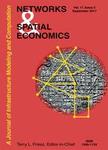版权所有:内蒙古大学图书馆 技术提供:维普资讯• 智图
内蒙古自治区呼和浩特市赛罕区大学西街235号 邮编: 010021

作者机构:Univ Tokyo Inst Ind Sci Komaba 4-6-1Meguro Ku Tokyo 1538505 Japan Univ Tokyo Ctr Real Estate Innovat Hongo 7-3-1Bunkyo Ku Tokyo 1130033 Japan
出 版 物:《NETWORKS & SPATIAL ECONOMICS》 (Netw. Spat. Econ.)
年 卷 期:2024年第24卷第1期
页 面:261-290页
核心收录:
学科分类:1201[管理学-管理科学与工程(可授管理学、工学学位)] 08[工学] 0823[工学-交通运输工程] 0812[工学-计算机科学与技术(可授工学、理学学位)]
基 金:Japan Society for the Promotion of Science (JSPS), Grant-in-Aid for Scientific Research (B) Grants-in-Aid for Scientific Research [23K21014] Funding Source: KAKEN
主 题:Electric vehicle Charging infrastructure In-motion wireless power transfer Mixed integer programing Intelligent transportation system
摘 要:The popularization of electric vehicles (EVs) is limited by their driving range and long charging times. To address this, in-motion wireless power transfer systems (WPTSs) are currently attracting attention as a new power supply system. In-motion WPTSs have coils embedded under the road to transfer power from the WPTSs to EVs while driving. However, the main drawback of WPTSs is their large investment, especially in supporting the long-distance trips of EVs on expressways. Therefore, this study proposes a new mixed-integer programming model (MIP) to determine the optimal location of WPTSs for maximized total feasible flow demand. By focusing on long-distance trips on expressways, we propose the first flow-capturing model for WPTS locations that can (i) solve for the distance of WPTS installed as continuous variables, and (ii) solve problems based on real-scale data using a general MIP solver. Our method is extended to a discussion of WPTS installations on expressways in Japan. We observe that WPTS has strong potential as an EV power supply system in terms of coverage and economic rationality. In particular, WPTS has economic rationality not only in busy networks but also in sparsely populated networks that connect urban and rural areas. Thus, this study clarifies the important insights of WPTSs in improving their effectivity to narrow down the demand and ensure the flexibility in the locations of WPTS.